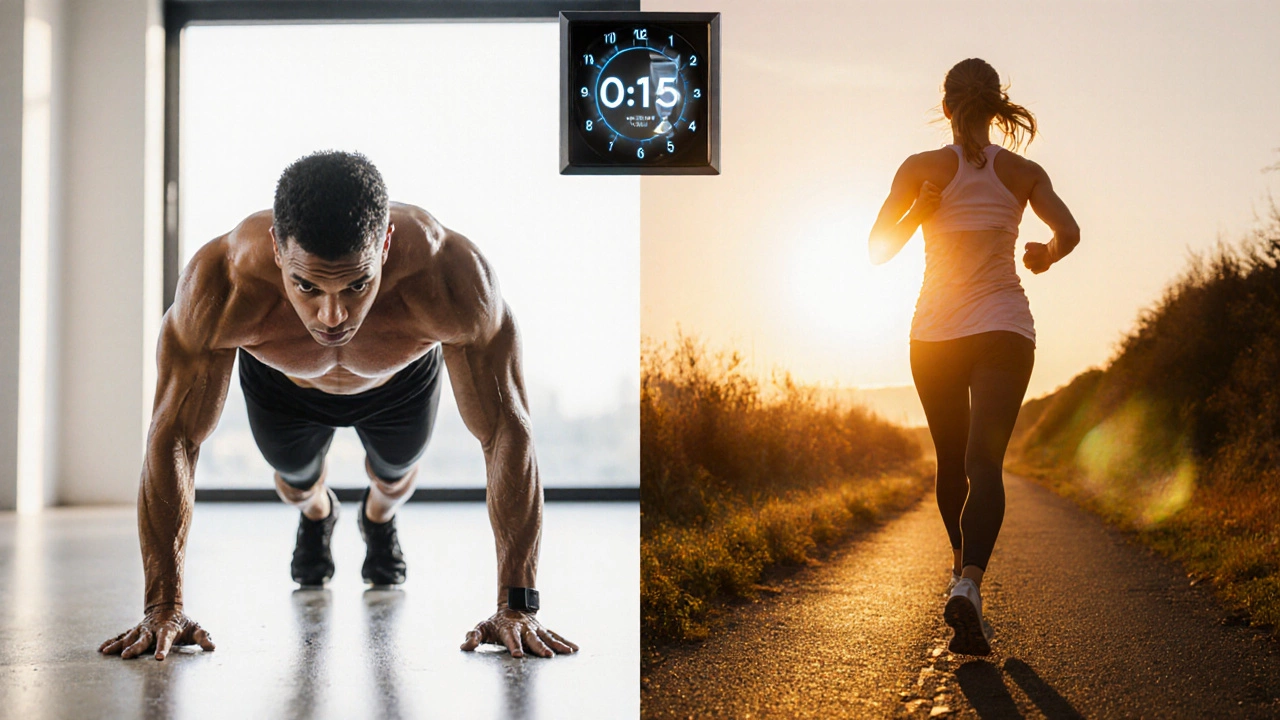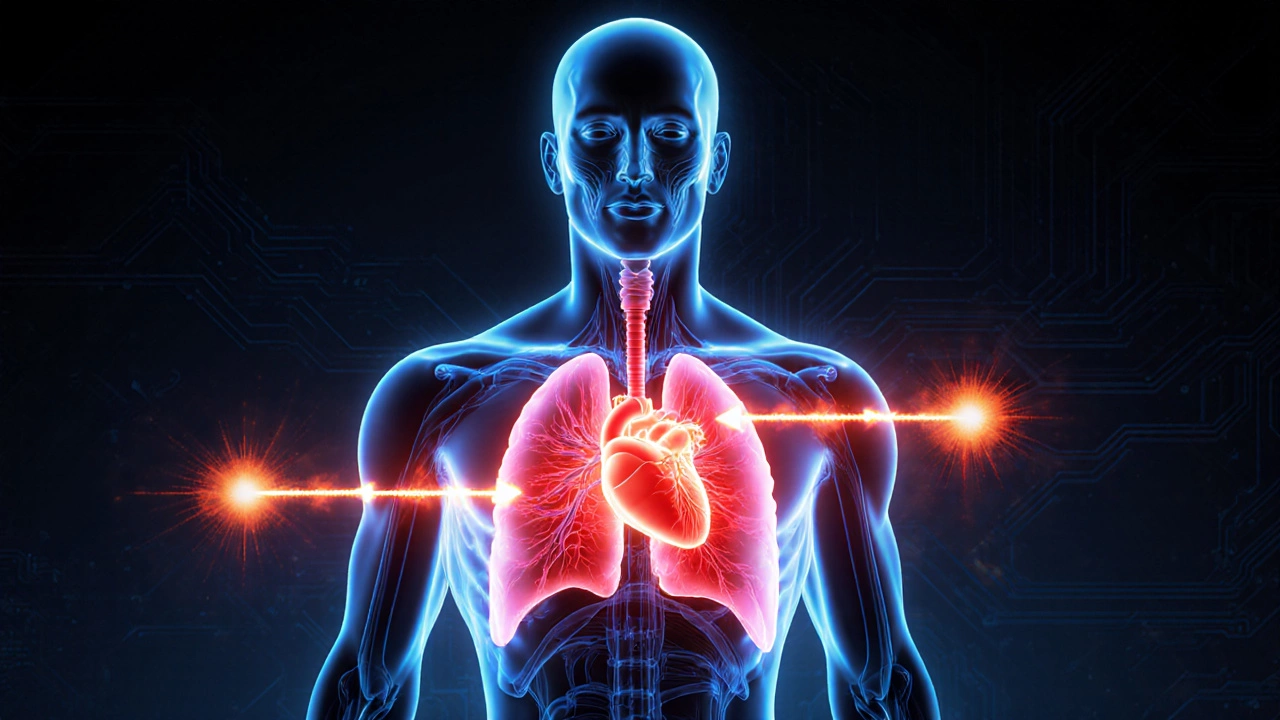HIIT vs Running: Which Is More Effective for Fitness?

HIIT vs Running Efficiency Calculator
Calculate Your Workout Calories
See how many calories you burn with HIIT versus running for your specific session duration
Key Takeaways
- HIIT burns more calories in less time, thanks to the afterburn effect (EPOC).
- Steady‑state running improves endurance and is easier on joints for beginners.
- Both workouts raise VO2 max, but HIIT does it faster.
- If you want a mix of cardio and strength, HIIT is the clear winner.
- Choose based on your schedule, injury history, and personal goals.
When the question “Is HIIT better than running?” pops up on fitness forums, the debate quickly spirals into opinions about calories, heart health, and time constraints. The answer isn’t a simple yes or no. It depends on what you’re after - rapid calorie burn, endurance, muscle tone, or a low‑impact routine. This guide breaks down the science, the numbers, and the practical side so you can decide which workout fits your life.
HIIT is a high‑intensity interval training method that alternates short bursts of maximal effort with brief recovery periods. Typical sessions last 10‑30 minutes, but the intensity creates a metabolic ripple that lasts hours after you finish.
Running (often called steady‑state cardio) means maintaining a moderate pace for a continuous period, usually 30‑60 minutes or more. It primarily targets the cardiovascular system and is the classic “endurance” workout.
Physiological Differences: What Happens Inside Your Body?
Both HIIT and running raise your VO2 max - the maximum amount of oxygen your body can use during exercise. The key difference lies in how they achieve it.
- EPOC (Excess Post‑Exercise Oxygen Consumption): After a HIIT session, your metabolism stays elevated for 12‑48 hours, burning extra calories even while you’re sleeping. Running’s EPOC is much shorter, often returning to baseline within an hour.
- Lactate Threshold: HIIT pushes you above the lactate threshold, training your body to clear lactate faster. This improves both anaerobic and aerobic capacity.
- Muscle Recruitment: Jumping, sprinting, and plyometric moves in HIIT engage fast‑twist fibers, giving a modest boost to muscle hypertrophy. Running mainly uses slow‑twitch fibers, enhancing endurance but offering limited strength gains.
Calorie Burn and Time Efficiency
If you stare at the numbers, HIIT wins the calorie‑per‑minute race. A 20‑minute HIIT session can burn 250‑350 calories, and the afterburn can add another 100‑150 calories over the next day. In contrast, a 45‑minute jog at a moderate pace burns roughly 400‑500 calories but with minimal afterburn.
This makes HIIT a favorite for busy professionals who can only spare a half‑hour a few times a week. However, the high intensity also means you need adequate recovery - 24‑48 hours between sessions for the same muscle groups.
Cardiovascular Health
Both forms improve heart health, lower blood pressure, and increase HDL cholesterol. Studies from the American College of Sports Medicine (2023) show that HIIT can improve VO2 max by 10‑15% in eight weeks, whereas steady‑state running typically yields a 5‑8% rise over the same period.
For people with joint issues or early‑stage osteoarthritis, low‑impact running (treadmill or track) or walking may be safer. HIIT can be modified with low‑impact intervals like cycling or rowing to protect the knees.

Strength, Flexibility, and Functional Benefits
Because HIIT often mixes bodyweight moves (burpees, squat jumps, push‑ups), you get a functional strength component that running lacks. Over time, participants report better balance, higher core stability, and modest gains in lean muscle mass - typically 0.5‑1 kg after 12 weeks.
Running, especially on varied terrain, does improve bone density in the lower body, but it won’t give you the upper‑body tone that a well‑designed HIIT circuit delivers.
Injury Risk and Recovery
HIIT’s explosive nature can stress tendons and joints if you’re not careful. Common injuries include ankle sprains, hamstring strains, and lower‑back irritation. Proper warm‑up, technique, and progression are crucial.
Steady‑state running carries its own risks - shin splints, plantar fasciitis, and overuse knee pain are frequent complaints. The risk level often correlates with mileage and shoe wear.
Bottom line: Both can be safe when programmed correctly, but HIIT demands closer attention to form, while running requires mileage moderation.
Who Should Choose Which?
| Aspect | HIIT | Running |
|---|---|---|
| Session Length | 10‑30 minutes | 30‑60+ minutes |
| Calorie Burn (During) | 250‑350 kcal (20 min) | 400‑500 kcal (45 min) |
| Afterburn (EPOC) | 100‑150 kcal (12‑48 hrs) | ~20 kcal (1‑2 hrs) |
| VO2 Max Improvement | 10‑15% in 8 weeks | 5‑8% in 8 weeks |
| Strength Gains | Modest (0.5‑1 kg lean mass) | Minimal |
| Joint Impact | Medium‑high (modifiable) | Low‑medium (depends on surface) |
| Ideal For | Busy schedules, calorie‑focused, functional fitness | Endurance athletes, low‑impact seekers, outdoor lovers |
Use this table as a cheat sheet when building your weekly plan. If you have 3‑4 days to train, a blend often works best - two HIIT sessions and one longer run.

Sample Weekly Blueprint
- Monday - HIIT: 5‑minute warm‑up, 30‑second sprint on a bike, 30‑second easy spin × 10, 5‑minute cool‑down.
- Wednesday - Run: 45‑minute steady jog at 60‑70% max heart rate.
- Friday - HIIT (Bodyweight): 4 rounds of 40‑second burpees, 20‑second rest, 40‑second jump squats, 20‑second rest, 1‑minute plank.
- Saturday - Optional Light Run or Active Recovery: 30‑minute walk, easy cycle, or yoga.
Adjust intensity based on how you feel. The goal is to keep the heart rate in the target zones without overtraining.
Decision Checklist
- Do you have less than 30 minutes most days? → HIIT.
- Do you prefer outdoor scenery and a meditative pace? → Running.
- Are you recovering from a joint injury? → Low‑impact HIIT (cycle/row) or easy run on a treadmill.
- Is building upper‑body strength a goal? → HIIT with bodyweight moves.
Remember, the best program is the one you’ll stick with consistently.
Frequently Asked Questions
Can HIIT replace all cardio?
Yes, if your primary goal is calorie burn, VO2 max, and functional strength. However, long‑duration steady‑state sessions still offer unique benefits for marathon training and mental relaxation.
How often should I do HIIT?
Most experts recommend 2‑3 sessions per week, spaced 48 hours apart, to allow muscle recovery and keep injury risk low.
Is running better for heart health?
Both improve heart health, but steady‑state running provides a more gradual stress on the heart, which can be gentler for older adults or those new to exercise.
What if I have knee pain?
Choose low‑impact HIIT options (e.g., rowing, stationary bike) and keep runs short on soft surfaces. Consult a physiotherapist for personalized advice.
Can I combine HIIT and running in the same workout?
Yes. A popular hybrid is a “run‑interval” session: 2‑minute jog followed by 30‑second sprint, repeated 6‑8 times. This merges endurance and high‑intensity benefits.